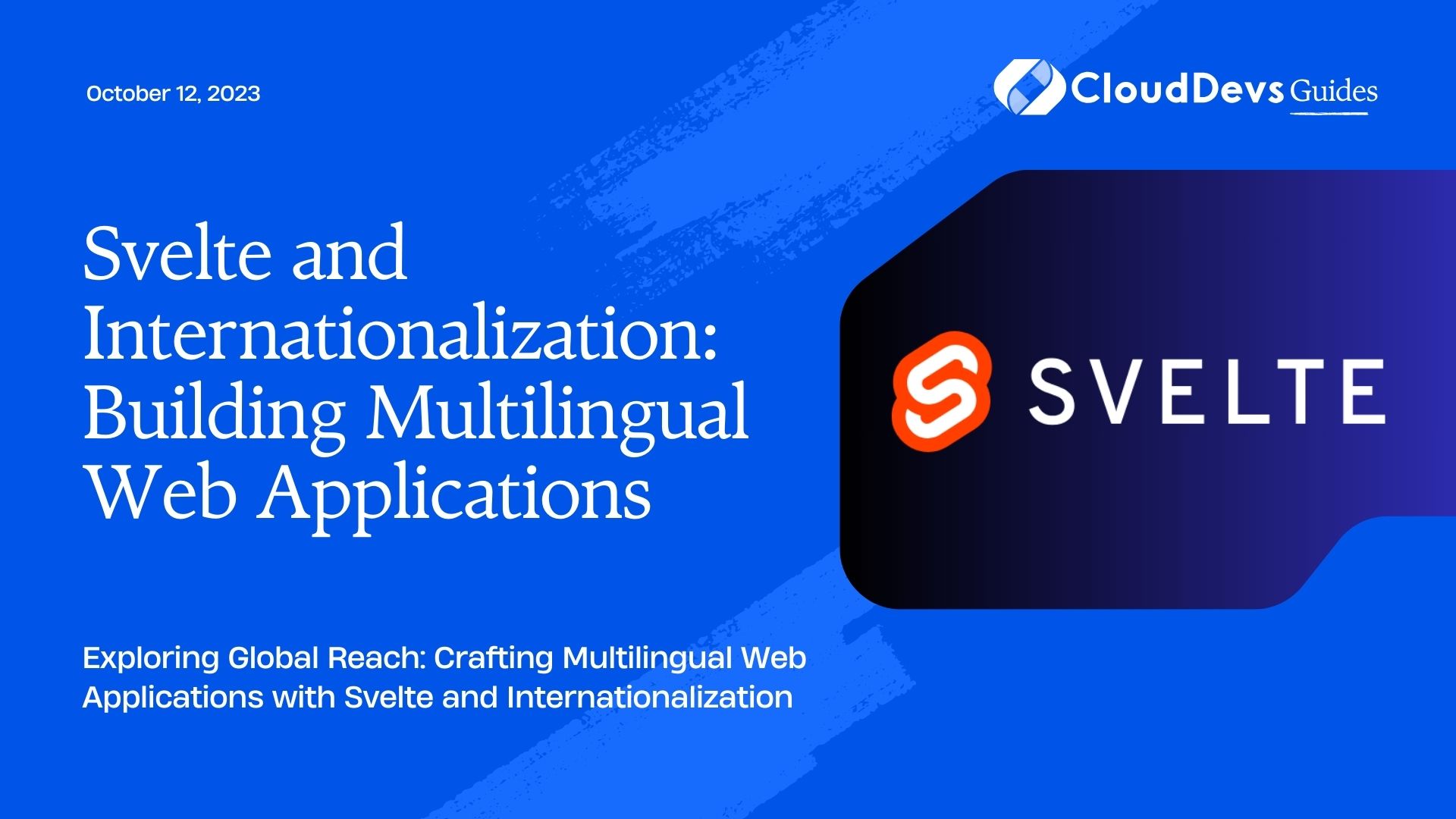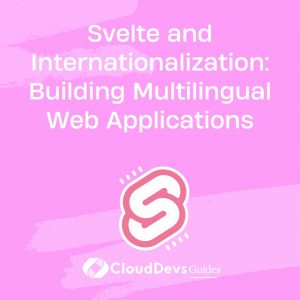Svelte and Internationalization: Building Multilingual Web Applications
In today’s interconnected world, catering to a diverse user base is essential for the success of web applications. One critical aspect of achieving this is creating multilingual web applications that can be easily accessed and understood by users across the globe. Enter Svelte, a cutting-edge JavaScript framework that not only simplifies the process of building dynamic user interfaces but also offers powerful tools for internationalization. In this article, we will delve into the world of Svelte and internationalization, exploring techniques, benefits, and providing code samples to help you create seamless multilingual experiences.

Understanding the Importance of Internationalization
Before we dive into the specifics of using Svelte for internationalization, let’s take a moment to understand why this aspect is so crucial. The internet has transformed the way we connect, and web applications are used by individuals from diverse cultural and linguistic backgrounds. Offering your application in multiple languages not only makes it more accessible but also enhances user engagement and user trust.
Imagine a scenario where a user lands on your application but struggles to navigate due to a language barrier. They are likely to leave the site frustrated and may never return. On the other hand, a user who finds the application available in their preferred language is more likely to explore and engage, leading to increased usage and potential conversions.
Getting Started with Svelte
Svelte is a unique JavaScript framework that shifts much of the work traditionally done at runtime to build time. This approach results in smaller, faster, and more efficient applications. If you’re new to Svelte, you’ll find its syntax intuitive and easy to grasp. Before we delve into internationalization, make sure you have a basic understanding of how Svelte works.
Creating a Svelte Project
To get started with a Svelte project, you need to have Node.js and npm (Node Package Manager) installed on your system. Once you have them set up, open your terminal and execute the following commands:
bash npx degit sveltejs/template svelte-multilingual-app cd svelte-multilingual-app npm install npm run dev
This will create a new Svelte project and launch the development server. You can access your application by opening your browser and navigating to http://localhost:5000.
Implementing Internationalization in Svelte
Now that you have a basic Svelte project up and running, let’s explore how to implement internationalization using Svelte. We’ll go through the process step by step, including setting up localization, managing translations, and updating the user interface.
Step 1: Adding Internationalization Libraries
Svelte doesn’t have built-in internationalization capabilities, but it’s easy to integrate third-party libraries to achieve this functionality. One popular library for internationalization is svelte-i18n. To add it to your project, open your terminal and run:
bash npm install --save svelte-i18n
Step 2: Setting Up Localization
After installing the svelte-i18n library, you need to set up the localization configuration. In your Svelte project, create a new file named i18n.js in the src folder. In this file, you can define your supported languages and their corresponding locales:
javascript
// src/i18n.js
import { init, getLocaleFromNavigator } from 'svelte-i18n';
init({
fallbackLocale: 'en',
initialLocale: getLocaleFromNavigator(),
});
Step 3: Managing Translations
With the localization configuration in place, it’s time to manage translations. Create a folder named locales within the src directory. Inside this folder, create JSON files for each supported language. For example, you can have en.json for English and fr.json for French. Each JSON file should contain key-value pairs representing translations:
json
// src/locales/en.json
{
"greeting": "Hello!",
"welcome": "Welcome to our application."
}
json
Copy code
// src/locales/fr.json
{
"greeting": "Bonjour !",
"welcome": "Bienvenue dans notre application."
}
Step 4: Updating the User Interface
Now that your translations are set up, you can use them in your Svelte components. Let’s say you have a component named Header.svelte that displays a welcome message. In this component, you can use the t function provided by svelte-i18n to translate the text:
svelte
<!-- src/components/Header.svelte -->
<script>
import { t } from 'svelte-i18n';
</script>
<header>
<h1>{$t('greeting')}</h1>
<p>{$t('welcome')}</p>
</header>
Step 5: Language Switching
Offering users the ability to switch between languages is essential. You can create a language switcher component that allows users to select their preferred language. Here’s a simplified version of how you can create such a component:
svelte
<!-- src/components/LanguageSwitcher.svelte -->
<script>
import { setLocale, getLocale } from 'svelte-i18n';
const supportedLanguages = ['en', 'fr'];
let currentLanguage = getLocale();
function changeLanguage(newLanguage) {
if (supportedLanguages.includes(newLanguage)) {
setLocale(newLanguage);
currentLanguage = newLanguage;
}
}
</script>
<select bind:value={currentLanguage} on:change={() => changeLanguage(currentLanguage)}>
{#each supportedLanguages as lang}
<option value={lang}>{lang}</option>
{/each}
</select>
Benefits of Using Svelte for Internationalization
Integrating Svelte with internationalization offers several benefits that contribute to the overall development and user experience:
1. Performance
Svelte’s build-time approach to rendering results in highly optimized code. This optimization extends to the internationalization process, ensuring that only the necessary translations are included in the final build, reducing the application’s size and boosting performance.
2. Developer Experience
Svelte’s simplicity and intuitive syntax extend to internationalization as well. The svelte-i18n library integrates seamlessly, allowing developers to focus on creating engaging user interfaces rather than dealing with complex localization setups.
3. Flexibility
Svelte’s component-based architecture makes it easy to encapsulate internationalization logic within components. This modular approach enhances code maintainability and allows for smooth collaboration between developers and translators.
4. Seamless Updates
As your application grows and evolves, so do the translations. Svelte’s dynamic reactivity ensures that any changes to translations are reflected in real-time without requiring manual intervention, streamlining the update process.
Conclusion
Building multilingual web applications is no longer a daunting task, thanks to Svelte and its integration with internationalization libraries like svelte-i18n. By following the steps outlined in this article, you can create web applications that cater to a global audience, offering a seamless experience in multiple languages. Svelte’s performance, developer experience, flexibility, and seamless update process make it an ideal choice for crafting internationalized applications that connect with users around the world. Embrace the power of Svelte and open your applications to a world of possibilities.
Table of Contents







